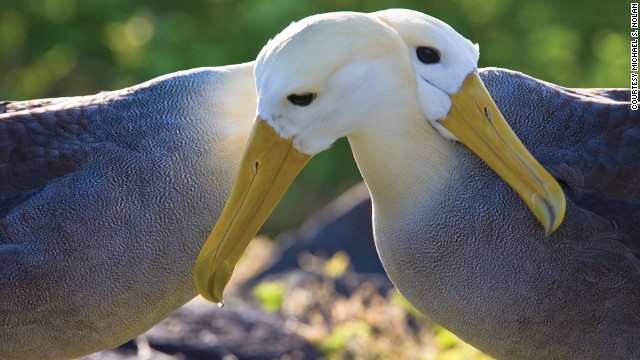My first foray into deep water brings me face to face with some of the islands' most ebullient locals.
As shoals of slim surgeonfish, parrotfish and clownfish wind between the gray rocks and drift in the current, they suddenly appear -- six Galapagos sea lions -- fat sleek bullets that zoom right up to my mask, upside down and mouths open, before twisting away at the last minute.
Clambering back into the Zodiac dinghy -- or panga, as they're known in the Galapagos -- for the short return trip to the National Geographic Endeavour, one fellow "explorer" quizzes our accompanying naturalist.
"Oh, they won't bite you," he reassures us. Less reassuringly, he adds: "Maybe. But just a little."
All the animals throughout the Galapagos National Park, more than 3,000 square miles of islands and islets 600 miles off Ecuador's mainland, are unperturbed by our presence.
As there are no big predators -- or people -- on most of the islands the animals show no fear.
And because many species are endemic to the Galapagos or even one of its 13 main islands, there's literally nowhere else in the world that you can have this kind of encounter.
Sailing for science
I'm aboard the conservation-focused, naturalist-led Lindblad Expeditions-National Geographic Endeavour, a ship that lets passengers connect with
life both above and below the waves through kayak and Zodiac excursions.
Unbelievably, the uninhabited islands are much as Charles Darwin experienced them in 1885.
Floreana, the second island on which Darwin landed, still has a "post office" that dates back to whaling days when crews would leave mail in a rum barrel.
People still leave postcards here to be hand delivered by future visitors (those I addressed to the UK arrived within two weeks via hands unknown).
"It's a land left untamed ... One of the last parts of the world that's really wild," says fellow passenger Jim Calaway, an investments portfolio manager from Illinois.
Daily recaps and talks by eminent scientists give cruises their characteristic research-meets-education feel.
Voyages also have a strong photography slant, with most on-board naturalists certified as photo instructors by National Geographic.
On Espanola, we boulder-hop along rough trails to reach an albatross nesting site, often stepping over groups of inky charcoal black marine iguanas.
Genovesa's rough, lunar landscape seems inhospitable but teems with seabirds, including half a million red footed boobies -- the largest population in the world.
Walking through prickly pear trees along a sandy path to Santa Cruz's aptly named "Cerro Dragon," (Dragon Hill) we spot 28 dusty-yellow-brown Galapagos land iguanas.
During that afternoon's ride to the eastern shore of Santa Cruz, dubbed "El Eden" for its scenic beauty, naturalist Giancarlo Toti doles out photo tips in time for us to snap a great blue heron feeding its gulping chick.
"I love these cruises because there's always one special thing for everybody," says Toti. "This for me was the most special thing this time -- the heron feeding its chick. I have never seen that before."
Exploration highlights
Exploring the Galapagos Marine Reserve -- the second largest in the world at more than 50 square miles -- is as integral to the expedition experience as the guided hikes across the islands.
(CNN)
Bakudaily.Az











